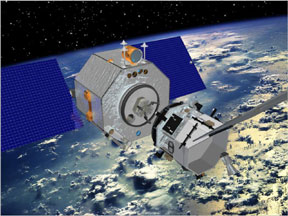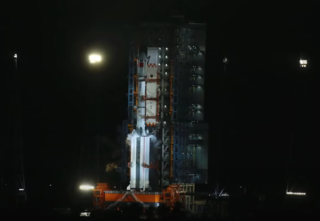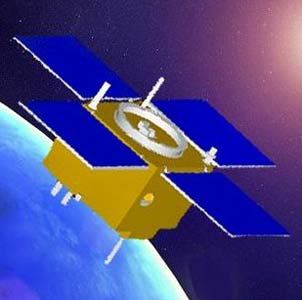
The Defense Advanced Research Projects Agency (DARPA) is a research and development agency of the United States Department of Defense responsible for the development of emerging technologies for use by the military.

The Infrared Space Observatory (ISO) was a space telescope for infrared light designed and operated by the European Space Agency (ESA), in cooperation with ISAS and NASA. The ISO was designed to study infrared light at wavelengths of 2.5 to 240 micrometres and operated from 1995 to 1998.

A space rendezvous is a set of orbital maneuvers during which two spacecraft, one of which is often a space station, arrive at the same orbit and approach to a very close distance. Rendezvous requires a precise match of the orbital velocities and position vectors of the two spacecraft, allowing them to remain at a constant distance through orbital station-keeping. Rendezvous may or may not be followed by docking or berthing, procedures which bring the spacecraft into physical contact and create a link between them.

SES S.A. is a Luxembourgish satellite telecommunications network provider supplying video and data connectivity worldwide to broadcasters, content and internet service providers, mobile and fixed network operators, governments and institutions.

Orbital Express was a space mission managed by the United States Defense Advanced Research Projects Agency (DARPA) and a team led by engineers at NASA's Marshall Space Flight Center (MSFC). The Orbital Express program was aimed at developing "a safe and cost-effective approach to autonomously service satellites in orbit". The system consisted of two spacecraft: the ASTRO servicing satellite, and a prototype modular next-generation serviceable satellite; NEXTSat. The mission launched from Cape Canaveral Air Force Station on 8 March 2007, aboard an Atlas V expendable launch vehicle. The launch was part of the United States Air Force Space Test Program STP-1 mission.
The Operationally Responsive Space Office is a joint initiative of several agencies within the United States Department of Defense (DoD). The "stand up" of the office took place 21 May 2007 at Kirtland Air Force Base. The first director of the ORS Office was Col. Kevin McLaughlin, who was also dual-hatted as commander of the Space Development and Test Wing located at Kirtland. The ORS Office focuses on providing quick-response tactical space-based capabilities to the warfighter utilizing smaller satellites, such as the Tactical Satellite Program and smaller launch vehicles.

Wigbert Fehse is a German engineer and researcher in the area of automatic space navigation, guidance, control and docking/berthing.

Docking and berthing of spacecraft is the joining of two space vehicles. This connection can be temporary, or partially permanent such as for space station modules.
Space Infrastructure Servicing (SIS) is a spacecraft concept being developed by Canadian aerospace firm MDA to operate as a small-scale in-space refueling depot for communication satellites in geosynchronous orbit.
The Mission Extension Vehicle (MEV) is a spacecraft that extends the functional lifetime of another spacecraft through on-orbit satellite servicing. They are 2010s-design small-scale in-space satellite-refueling spacecraft first launched in 2019. The MEV spacecraft grew out of a concept proposed in 2011 by ViviSat, a 50/50 joint venture of aerospace firms US Space and Alliant Techsystems (ATK). The joint venture was created in 2010 for the purpose of designing, producing and operating the MEV program.

Busek Co. Inc. is an American spacecraft propulsion company that builds thrusters, electronics, and various systems for spacecraft.
On-orbit satellite servicing refers to refueling or repairing space satellites while in orbit.
The DARPA XS-1 was an experimental spaceplane/booster with the planned capability to deliver small satellites into orbit for the U.S. Military. It was reported to be designed to be reusable as frequently as once a day, with a stated goal of doing so for 10 days straight. The XS-1 was intended to directly replace the first stage of a multistage rocket by taking off vertically and flying to hypersonic speed and high suborbital altitude, enabling one or more expendable upper stages to separate and deploy a payload into low Earth orbit. The XS-1 would then return to Earth, where it could ostensibly be serviced fast enough to repeat the process at least once every 24 hours.

NovaWurks is a seed-stage startup company that is developing a set of novel small satellite technologies that will enable new capabilities for commercial operations in space. NovaWurks is located in Los Alamitos, California. In 2013, the company received an important contract worth up to US$46,200,000 from DARPA for components for the Phoenix Project.
Olymp-K is a Russian geostationary satellite built for the Russian Ministry of Defence and Federal Security Service (FSB). The satellite is also referred to as "Luch". It is believed to be a signals intelligence satellite.

Shijian is a series of satellites built and operated by the People's Republic of China. Some Shijian-series satellites have drawn significant concerns from the United States government and space observers who cite unannounced launches, undisclosed sub-satellites deployed in orbit, unusual orbital maneuvers, and demonstrated rendezvous proximity operations (RPO) including the close inspection and towing of other satellites.
Astroscale Holdings Inc. is a private orbital debris removal company headquartered in Tokyo, Japan. The company is developing satellite end-of-life and active debris removal services to mitigate the growing and hazardous buildup of debris in space.

Shiyan is a Chinese experimental satellite program consisting of a variety of test satellites. Given the classified nature of the satellites, Chinese government statements regarding the missions of Shiyan satellites follow the common refrain of agricultural monitoring and space environment observation — the same offered for other classified programs such as the Tongxin Jishu Shiyan, Yaogan, and Shijian programs. Alternatively named Tansuo satellites, Shiyan satellites occupy varying orbits including low Earth, polar Sun-synchronous, geosynchronous, and highly-elliptical orbits and are believed to accomplish a diverse set of missions from rendezvous proximity operations (RPO) to earth imaging. Though similarly named, the Shiyan satellite program is not to be confused with the separate Shijian satellite program.
Gregory Falco is an American inventor and researcher. Falco is a professor at Cornell University. He is a pioneer in the field of cybersecurity research and its aerospace applications. Falco is the founding chair of IEEE's Standard for Space System Cybersecurity.

DARPA’s Robotic Servicing of Geosynchronous Satellites (RSGS) program leverages commercial space technology to inspect and repair aging or broken satellites in the geosynchronous Earth orbit (GEO), about 35,786 kilometers from Earth.











